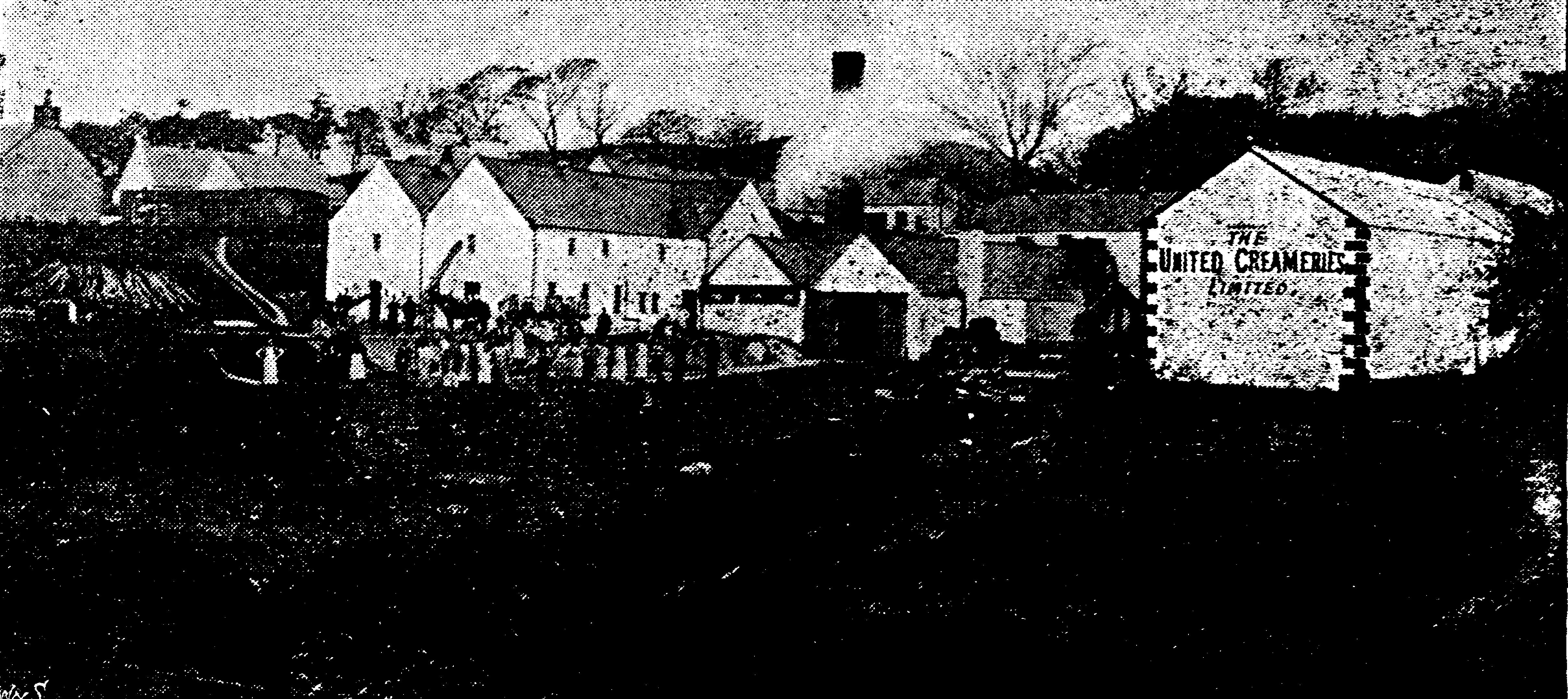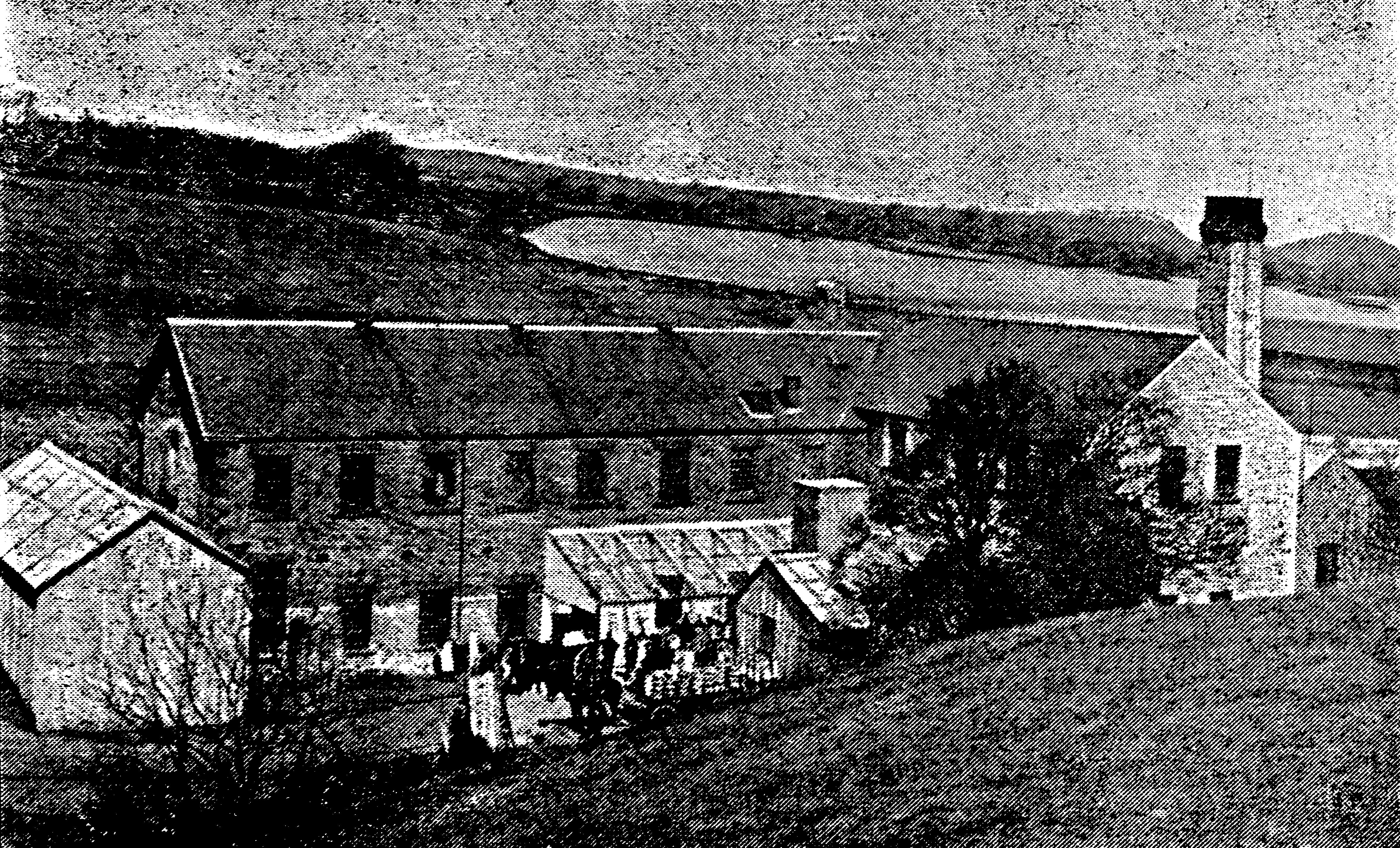
The United Creameries (Limited)
THE UNITED CREAMERIES (Limited), Glasgow.
One of the most ancient industries known in the worlds history may be recognised in its more modern form as represented by The United Creameries (Limited), which, from its commercial importance, fully merits prominent recognition in these columns. The business, originally established in 1882 as a private enterprise by Mr. Andrew Clement, of Glasgow, and Mr. Robert McCracken, a Wigtownshire farmer, was afterwards formed into a joint-stock company under the title of The Creamery Co. (Limited) ; and, on the amalgamation of this concern with the Valleyfield Dairy Co. (Limited), in Kirkcudbrightshire, was altered to its present style, and is now the most extensive undertakings of this kind in Great Britain.

The premises of the Company are situated at Dunragit, in Wigtownshire, about six miles from Stranraer, and at Tarff, about three miles from the county town of Kircudbrightshire, in the midst of the finest dairy district in Scotland, where large herds of Ayrshire cows are kept, many of the farmers keeping from 80 to 150 cows, the milk of which goes to the Creameries. Situated as this district is on the shores of the Solway Firth, the climate is all that can be desired for carrying dairy operations to a successful issue. This south-west corner of Scotland being destitute of minerals has not been cut up by mining operations, nor has it been disfigured by huge chimney stacks belching forth volumes of smoke and noxious fumes to pollute the atmosphere. It is, as yet, entirely devoted to agricultural pursuits, especially that of dairying.
The premises at Dunragit comprise commodious and conveniently arranged buildings covering an extensive area. At the entrance to the Creamery are the handsomely appointed offices, from which the visitor is introduced to the receiving department, where the milk supplied by the farmers in the locality is received and weighed. The entrance to this apartment is besieged every morning for three hours by an array of farmers carts and spring vans, which deliver a quantity of milk varying from 3,500 to 4,500 gallons daily. A large number of samples of milk are tested daily, and every precaution is taken to preserve its purity. Farmers supplying milk are prohibited from using foods known to be injurious to the quality and flavour of the produce, and the Company reserve the right to inspect the farm premises and to see that proper sanitary conditions are maintained. Consequently, all the milk which passes through the Creameries is pure and of the best quality. From the weighing machines the milk then passes to the vat-room, where it is stored in large vats of the capacity of 800 gallons each ; from these it is conveyed by means of tin-lined pipes to the warmers, and thence to the centrifugal cream separators. These appliances are five in number two Danish (Burmeister and Wains patent), two De Laval, and one Victoria separator all of modern construction, from which skim milk and cream, when separated, flow to their respective reception vats to wait the next process. Part of the cream is made exceptionally thick, and after being very thoroughly chilled, is put up into neat little earthenware jars carefully sealed, and is despatched to the cities every afternoon. This cream, which keeps sweet for at least fourteen days, is highly appreciated for table use by many city people. The remainder of the cream, which is used for making the delicious fresh butter for which the Company are famous, after being partially cooled, remains in the vats till sufficiently ripe for churning. The churns are two in number: the larger, in which operations are carried on twice or three times daily, is of the ordinary Scotch pattern, and has a capacity of 300 gallons, while the smaller square ton churn is kept in reserve in case of accident. After being removed from the churn the butter is taken to the making-up department, which is supplied with a large butter worker, fitted with a marble revolving table, on which the water is expressed from the product of the churn. This machine, like the centrifugal separators, is driven by steam power, which is freely utilised throughout the establishment. The butter, which is kept perfectly fresh, is, after being weighed into half-pounds, passed to the pressing room, where it is pressed into round and square patterns to suit various markets and packed into large boxes fitted with shelves, which are sent to Glasgow, Edinburgh, and other large towns by the evening trains.

During winter the separated milk, after coming from the centrifugal, is first carefully scalded and then thoroughly chilled by being passed over large capillary refrigerators to enhance its keeping qualities, and then filled into cans for consumption in the cities milk sent to Glasgow and Edinburgh being in time for evening delivery to consumers, while that sent to the English towns is in good time for early morning use.
During summer, when there is little demand for separated milk, cheese is made, which is one of the specialities of the Company and for which there is always a good demand. The cheese-making room is supplied with three large double-cased rectangular vats of 600 gallons capacity, fitted with cold water and steam for controlling the temperature during the delicate process of cheese making. In these the milk is coagulated by means of rennet, after which it is cut into small cubes and carefully stirred to allow the whey to escape. After the curd is sufficiently consolidated, it is torn to pieces by a curd mill, salted, and carried to the press-room, where the cheese are pressed horizontally in gang presses to expel the remaining steam, after which they are taken upstairs to the curing room, where they are placed on shelves and turned daily. After being in this room, which has storage capacity for 1,500 cheese, for about a month, the temperature being kept uniformity at about 70° F., they are ready for sale. The whey and butter-milk are used for feeding pigs, of which about 300 are kept in piggeries, situated at a distance from the Creamery.
But the most important branch of business carried on by the Company is the manufacture of margarine, for which there are ample facilities at both establishments. An abundant supply of cold spring water is provided, and this is further chilled by means of freezing machines. One of these machines has cooling capacity equal to 8 tons of ice per day. This department is entered by the store on the upper floor, where are piled-up casks of raw material, oleomargarine, which consist of the finest beef fat, partly of home production, and partly from the large slaughtering establishments of Chicago. From the store the oleo passes to the melting room, where the various fats are melted and prepared for churning. From this apartment, it gravitates to the churns, situated at the lower level, where it is carefully churned with new milk and blended with the finest Danish butter, and then run out into large tanks of cold spring water which has been previously chilled by means of the freezing machines alluded to above. From the churn room, the product passes in trucks, containing 7 to 8 cwts., to the working room, where it is salted and worked between powerful fluted rollers and prepared for the packing department. Here we find a lot of men busy at work weighing and packing up the finished blends and margarines in a great variety of packages of all shapes and sizes, from half-pound prints to hundredweight casks. A large quantity is packed in hermetically sealed tins for export to foreign countries and for ship-store use. The vat store, immediately adjoining, is an immense building of three stories, packed from floor to ceiling with all sorts of packages to meet the requirements of the different markets.
The extent of the margarine plant may be imagined when it is noted that its capacity is about 150 tons per week. For dispatch of goods, the Company are provided with a private siding running into the works. Being situated on the main line of the Royal Mail route to Ireland via Stranraer and Larne, the Company have exceptional facilities for dispatch of their products not only over Scotland, but over the Midlands and North of England.
The services of an adequate force of hands numbering from 40 to 50 are employed in the several departments, and for these every provision is made for recreation, an extensive reading room and library being provided by the thoughtful kindness of the Directors for the use of the workpeople. The establishment is conducted throughout with the perfection of order and system, the most scrupulous cleanliness being observed in every process ; and the entire arrangements of the management in the capable hands of Mr. M. Cracken, the managing director, are distinguished by the highest form of administrative skill.
At the Tarff factory the buildings, though not quite so extensive as those at Dunragit, are much more compact, and the large airy apartments, with lofty ceilings, are particularly well adapted to the Companys business. The arrangements here are very similar to those at Dunragit already described, the plant in both the dairy proper and the margarine department being proportionately less in capacity. The quantity of milk handled is about 3,000 gallons daily, while the margarine churns are capable of turning out about 100 tons per week. The cream separaters here are of the Victoria pattern. Two square box revolving churns are in daily use, and the fresh butter is worked and weighed into half-pounds automatically by an ingenious machine invented by one of the employees of the Company, while the cheese room is fitted with turning shelves, which greatly facilitate the work of turning the cheese. The machinery here is driven by a 20 h.p. turbine wheel and an 80 h.p. steam engine.
The offices and works are all lighted by electricity, so as to avoid any possibility of the products being damaged by the smell of paraffin or other mineral oils. These products are very widely distributed over the Kingdom and abroad by the enterprising agents of the Company, Messrs. Andrew Clement and Son, who have their headquarters at 21, South Albion Street, Glasgow, and branch establishments in London, Liverpool, Manchester, and Newcastle, with agents in all the principal towns. These home factories bid fair to supply the needs of our own country hitherto dependent on Continental shipments and thereby secure the circulation of thousands of pounds annually amongst our own people.
Back to Index of Firms (1891)